The "How-To" Guide to Understanding Gun Holsters
August 03 2015
Firearm "Holsters" are known to be one of the most complicated accessory items you'll ever potentially purchase for your firearm and its intended use. If holsters were simply a one-size-fits-all accessory, then a very large portion of the firearm accessories industry wouldn't even exist. The sheer number of variations involved can make choosing the correct holster a rather daunting task and more times than not, leads to entire bags filled with variations of holsters in a closet that never really get used, except maybe as the occasional door-stop. With all the variations, options, materials, colors and so forth offered, people usually settle on using and relying on one or two of the previously purchased ones to prevent spending countless hours searching for other variations that might possibly not cater to their needs again.
Over the next few pages, we will take some time running through the correct approach to understanding, searching and identifying the foundation from which you can then move forward into narrowing down your selections significantly, specifically before you ever begin browsing through the possible holsters available for purchase.
UNDERSTANDING HOLSTERS
Instead of beginning with traditional approaches like choosing the right holster, we need to first ensure that the topics and concepts that revolve around these tools are laid out and understood from a basic standpoint. This will then assist in understanding how these topics and concepts can be applied to the selection process narrowing important elements to best serve our intended needs. With that in mind, let's get started!
MATERIALS
LEATHER - Quite possibly the first and more likely than not, the oldest material that holsters have been fabricated from is Leather. A good leather holster is something that can last you a lifetime and will actually season with you accordingly. The more a leather holster is worn, the more comfortable it will become as it conforms to the user.
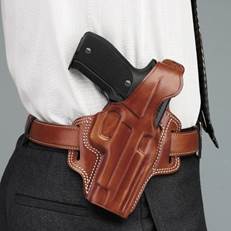
Leather is a material that can occasionally be worn against skin without too much irritation. It may stick a little, but unlike wearing other holsters like nylon or kydex, it won't really scratch or chafe.
A notable bonus for leather is that it can be very attractive to the eye. There are many holsters that can be worn and look very professional and stylish when compared to others. Traditional leather holsters come in common colors and can even offer combinations of brown or black. They can be made from a smooth finish or a subdued suede and can be treated to be rather soft, thick and sturdy, so regardless of what your preferences are, there's usually a leather holster that will fit your specific taste.
Many modern holster designs will actually include a mixture of materials like Leather and a Composite of some kind. Usually, these holsters have the leather portion designed to fit next to the body specifically addressing the comfort level of a good leather material.
COMPOSITES - There are many types of holsters on the market today that have constructed from kydex or other forms of synthetics and plastics. The very nature of these materials tend to make them very durable and relatively affordable. These characteristics have also made it possible for a great many of these holsters to begin incorporating simple mechanical devices that serve to lock the firearm into the holster, providing leverage and security in ways that most holsters comprised of other materials can't replicate.
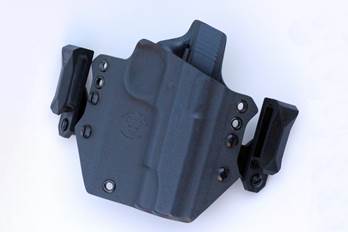
Since these materials are available in many variations of colors, when it comes to choosing a holster that will either be pleasing to the eye or finding something that will simply match your gear, you are almost certain to find the one you want or need.
NYLON & CLOTH - There are holsters out there made from different types of heavy duty fabrics. More often than not, these holsters have an interior frame that creates a pocket in which the firearm will sit as well as an over flap which completely envelops the firearm. These holsters tend to do a fantastic job in protecting the firearm itself from exposure to outside environmental elements and are often extremely durable as well as resistant to scratches or damage that usually would cause harm to more traditional leather or composite holsters.
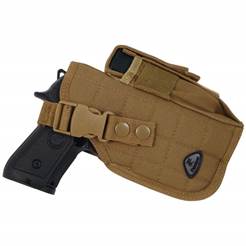
The down side more often than not to these styles of holsters is found in their ability to protect the firearm within. The over flap means that drawing the firearm requires you to usually unhinge or unbuckle the over flap, pull it clear of the firearm and only then can you access the grip to draw from the holster.
OTHER - There are other materials out there which are used to manufacture holsters and tend to come in multiple variations. For example, you might find a holster made of a rubber material with a fabric over lining which can serve to certain advantages. In fact if you really wanted to, you could actually carve a holster out of wood. The key element to take into account regardless of what material is being utilized is to ensure that the material's properties will help you achieve what you're looking for in your holster with durability, safety, protection and comfort of use always in mind.
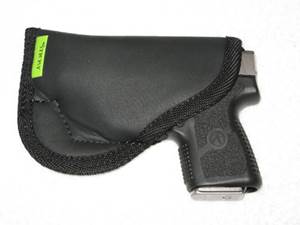
LEVELS
Modern holsters are almost always identified with a "Level" designation by their manufacturers. In essence, levels are what are used to describe the amount of "retention" (the ability to retain or hold the firearm within the holster regardless of outside influences) of the holster. In simple terms, levels identified for retention above level 1 can lead you to expect to find a mechanical device of some kind that locks the firearm into the holster itself and must be deactivated before the firearm can ever release. For example…
Level 1 = Pressure retention (the holster presses against the firearm, usually around the trigger guard, in order to retain the firearm. Once the pressure is overpowered, then the firearm will come free of the holster.
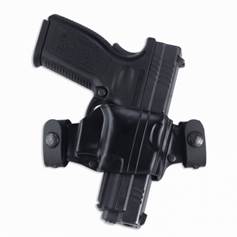
Level 2 = There is at least one mechanical device of some kind that will lock the firearm into the holster. Unless this device is deactivated then no amount of pressure will allow the firearm to come free unless it is enough to simply break the retention device. These devices are very often reinforced and very difficult to break.
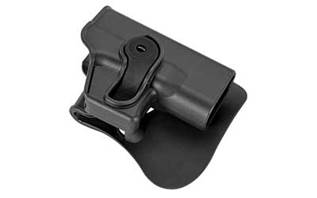
Level 3 = Two mechanical devices are now incorporated into the holster that must be deactivated in order to allow the firearm to release from the holster and more difficult to break in comparisons to level 2 holsters.
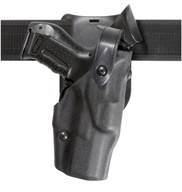
Level 3 is not currently the max level for retention and available option amongst variations of holsters in the marketplace. Nevertheless, amongst leading holster manufacturers, level 3 is traditionally the peak as anything that can be identified as a level 4 or higher holster would usually create too much burden on the user wearing the holster, particularly in order to draw a firearm in a timely manner! However, if you do find a level 4 or higher, than the same principle applies as both Level 2 and 3 holsters and you can expect to find another mechanical device that locks the firearm into the holster.
As previously noted, most level 2 or above holsters tend to be made from Kydex and other Synthetic materials since it allows for design and structure with little to no give, unlike softer materials like leather or nylon, which has been adopted as a requirement in order to mechanically lock the firearm into place.
Generally speaking, the higher the holsters level of retention, obviously the bigger and bulkier the holster becomes. This isn't much of a problem in regards to the design concept, however, since the real essence behind using a holster of level 2 or higher retention is generally to allow for some kind of open carry, always allowing the wearer to retain their firearm during physical activities all the while creating difficulty for another person to grab the firearm from the holster itself. Considering this, higher level holsters will always be harder to conceal. Most Law Enforcement departments require a level 2 or higher holsters for officers in uniform.
CARRY LOCATIONS
In all reality, imagination is the only real limit to where one can wear or store a firearm, whether on hand or mixed within gear. The old adage of being able to "pull a rabbit out of a hat" can ultimately be applied to a firearm. If the gun will fit and one can gain access to it quickly, then just about anywhere can work. It should be noted though that drawing your firearm from wherever you choose on your body should be something that you practice routinely, be comfortable and essentially become a natural reflex. Muscle memory is the key element and should be the number one factor when deciding carry location.
HIP CARRY - By far the most common location for a firearm is to be attached and traditionally worn is somewhere on the hip. In fact, having a firearm attached to the side of your body is what labeled handguns and pistols to sometimes be referred to as "Side Arms".
Quite often a holster will be designed with a specific location in mind, even down to where on the hip it should be worn. In these cases, most manufacturers use a clock system to indicate where the holster was designed to fit naturally and is usually referred to in relation to a right handed individual. In these cases 12 o'clock is referred to as directly below your belly button, 3 o'clock directly on your right side, and so forth. This comes in handy when we are determining if the holster will work for the specific location one prefers.
The other key element to consider here is that most holsters are either designed to be worn exposed or concealed. Inside the Waistband holsters are most often referred to as "IWB" and are almost entirely designed for concealment purposes.
Where you carry a firearm on your hip it is greatly dependent on what will be the most comfortable way for you to wear it throughout the day (standing, sitting, moving, driving, etc.), and the best way for you to access it in the situations you might find yourself. Basically, this means that when you are thinking about where to carry your firearm, you shouldn't just strap it to your side and go about your business, but really consider the activities within your day and select the most viable location. Put a little thought into exactly where on your hip the firearm will serve you the best.
For example, perhaps you spend a lot of time inside a vehicle driving for the better half of a day. Because you are in a seated position and seated against the back of a chair, a small of the back carry option might not be very comfortable nor reliable and won't serve for a very easy draw of the firearm. Using the same analogy, the seatbelt buckled to your right side while you're driving might make it difficult to access the firearm if you should need it quickly. So, in this instance it might not be a bad idea to wear the firearm on your left hip and train for a "cross draw" motion (simply meaning your firing hand is drawing from the opposite hip). There are far too many scenarios to consider, but you should get the general concept and make the proper considerations in advance.
Benefits for a strong side carry: Carrying the firearm on your strong side makes for generally easy draw motions and accommodates for the widest range of options in holsters designed and offered today.
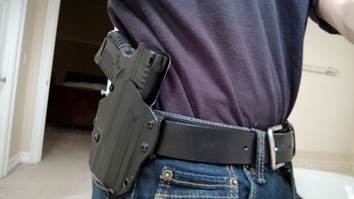
Benefits for a cross draw carry: Allows for a very easy and comfortable draw and also frees up the pockets on your dominant side for more common use that might otherwise be hindered when wearing a holster on the same side. This doesn't mean you can just use the pockets on the other side and use your non-dominant hand for things going in-and-out of it routinely. This is simply a comfort preference.
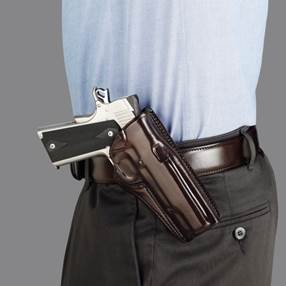
Benefits for an appendix carry: Carrying in your appendix allows for a very easy concealability as most shirts fall more freely in the front and back then they do on the sides. It is still a very easy, and in many cases, faster draw from the holster with your firearm. It can however prove uncomfortable with some body types and firearm frames when you're sitting.
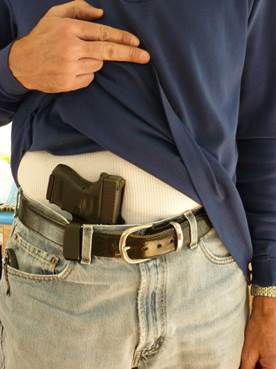
Benefits for a small of the back carry: Similar to the appendix carry, this usually provides for improved, if not the easiest, amount of concealability when wearing under a shirt or over garment. Clothing tends to hang a little more freely in the back and will overlap the firearm without pressing up against it much, making it easier to conceal than other locations around the waist. However, this is possibly the slowest and most challenging place on your hip to draw your firearm from. It also creates a potential problem, if you haven't practiced drawing from this location. It is not uncommon for people to muzzle themselves or people around them as they draw from the small of the back and swing the firearm around their body to point at the intended target. Something to highly consider before committing to this carry location.
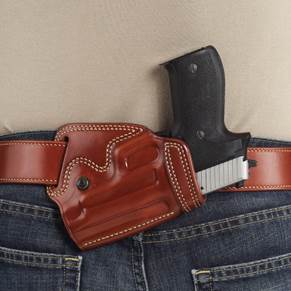
SHOULDER CARRY - Who doesn't love the sleek look from all those wonderful cop shows where the detectives have their gun hanging under one arm, and some spare magazines under the other? All strapped on by a rather attractive looking leather harness, this detective looks like he's ready to put the squeeze on you or shoot it out with a dangerous suspect that plans to never be taken alive! Generally, speaking though, a shoulder carry is a very viable and comfortable option for someone that wears a firearm routinely.
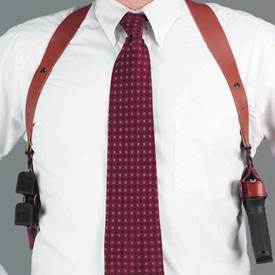
The real benefits to a shoulder holster system are comfort, accessibility, retention, and concealability.
When we put on a shoulder harness that hangs the firearm underneath our arms, it takes very little time for us to become accustomed to it being there and if you are using the belt clips that often are sold separately, then you can lock the harness in place and go through your entire day with little to no hindrance of any kind. They make the firearm very easy to access, just imagine someone standing in -20° C weather crossing their arms and baring hands in armpits, same concept and that simple in accessing your firearm quickly and extremely proficiently. Shoulder harnesses make it very easy for us to retain our firearm from others as well. Just like in football where the ball is tucked up into the armpit to help keep hold of it. Finally, another advantage with a shoulder harness is all you need to conceal your firearm is an over garment or jacket of some kind.
There are a few drawbacks however. Similarly to drawing from the small of the back, there is a very real danger for you to muzzle yourself or others around you as you draw the firearm and it should be practiced regularly to ensure you can perform the action safely. Along the same line and draw backs to the small of the back carry, it might not be the fastest place to draw your firearm from in relation to say an appendix carry. Bottom line, just as with every other carry location, if you choose to carry from a shoulder holster you should be practicing this method of carry routinely to ensure you are safe and proficient.
THIGH & ANKLE - The first thing we should note here is that when it comes to a thigh holster, there are two VERY different types. One style is made entirely for concealability and the other is a bulky design which is used for more tactical purposes. These tactical style holsters are often referred to as "drop leg" rigs and you can read more about these types in the "Modular" section as well as "Attachment Method" section. In this section though, we're going to discuss and focus on the concealable thigh and ankle holsters.
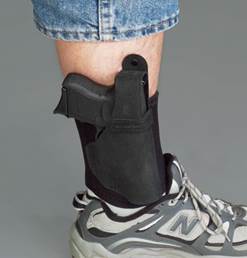
Ankle holsters are basically straps that wrap around your ankle, allowing one to wear a firearm on their ankle. The real benefit here is the extreme concealability these holsters provide. Usually best worn with a firearm on the inside of the non-dominant ankle, these holsters make it easy to carry a firearm under pant-legs and are a fantastic choice for people that spend the vast majority of their day in a seated position.
With an ankle holster, if you can tie your own shoes then you can essentially reach and draw your firearm. The real elements that are commonly overlooked and lead to potential problems are the firearm's size and pant leg length.
Simply put, anything that is attached to the outside of your ankle is going to be flopped around consistently throughout the day, from walking or even potentially running. Because of this one element, smaller frame firearms like compact revolvers or sub-compact semi-automatic pistols tend to be the better choice for an ankle carry.
Another element to always consider is that your pants lengths will usually need to be a little longer than normal when wearing an ankle holster. This is due to the fact that when we sit down, the bending action in our legs requires more length of fabric to ensure that the pant cuff still fully covers the firearm around the ankle ensuring concealability.
Thigh holsters that are made for concealability have similar elements and concepts as those of ankle holsters. The only real difference is of course that it is worn higher on the leg and can help you conceal a firearm even when wearing shorts, skirts or dresses. The biggest thing to remember here is that if you are wearing shorts, you need them to be loose enough to easily access the firearm as well as long enough to ensure it remains covered by material even when sitting.
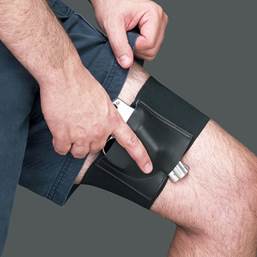
POCKET CARRY - There are plenty of firearms that will fit right into your pocket. Just because they will fit doesn't necessarily make this a valid and safe option for carry unless you take a few things into consideration first. Pockets can pose potential problems because we tend to use them so often throughout our daily routine. Our hand going in-and-out, taking out keys, pens or any other number of objects means that there is always the potential for something to interact with the trigger. This is the first element of having a pocket holster to ensure that the trigger is always secluded.
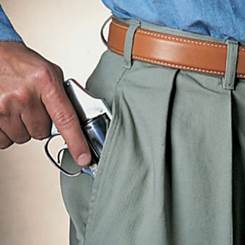
Another key element of carrying your firearm in your pocket is that when you need to draw it, sometimes the sights might catch on the rim of the pocket and prevent you from drawing quickly and smoothly. This is another common factor to consider in having a pocket holster which will assist in preventing this issue. Pocket holsters are designed to allow for the firearm to be drawn efficiently and the holster itself remain in the pocket when doing so.
If you're going to carry a firearm in your pocket, you really should have it inside a holster and designate a single pocket for the purpose of carry. Do not intermingle other items or objects with your firearm.
DEEP CONCEALMENT - There are some holsters that are designed to be worn along with our base layers of clothing and including a normal garment worn over them. Often times, these holsters are referred to as "deep conceal" holsters. There are belly bands that retain a firearm to your belly or chest and then any shirt can be worn over, there are undershirts and bras with holsters sewn directly into them and there's even underwear that will you let you pack a little extra heat (forgive the pun).
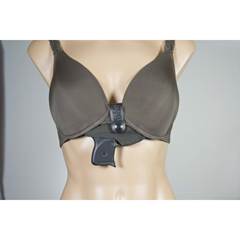
Ultimately, these holsters are designed with one major element in mind, obviously concealability. The benefit to these holsters is that you can ensure you have your firearm on you in almost any situation. Unfortunately, they don't beat metal detectors so you might not want to wear one of these when going to your next court hearing for that red light ticket, but with a deep conceal holster you can be safely armed at events you might normally be able to blend a firearm into. You could even wear one of these under a tuxedo or evening dress if you needed for extra insurance and safety.
The down side to these holsters is also pretty obvious, they aren't always very easy or comfortable to draw if that moment presents itself quickly. The real factor behind these holsters is that while they might not always be very easy to access, you do still have your firearm on you when you otherwise might not even have been able to do so. When the time comes, most people would probably find they can strip away whatever clothing is in the way to gain access to their firearm with surprising ease, but if you do carry using this method, you should still practice drawing from your holster wearing similar clothing to what you'd be wearing over it.
BAGS, PACKS, & PURSES - More and more accepted as a viable option to carry a firearm using a bag, pack or purse that is designed to hold a firearm can be a very effective and viable solution to ensuring you don't even have to worry about your wardrobe while still ensuring you have access to your firearm. If you carry a back pack, fanny pack, satchel, purse, brief case or in some cases even a daily planner, there are holsters that can accommodate for your daily carry.
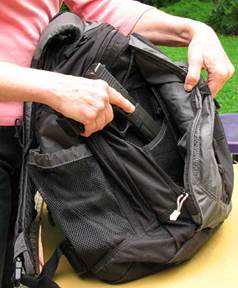
The real bonus to these types of holsters is that they blend in perfectly with normal life and because they are designed to hold a firearm, you can ensure a much safer carry then if you just put a firearm into any old bag. These packs come with a very specific holster pouch that is designated for the sole purpose of your firearm as well as backup magazines. This helps ensure nothing else you are carrying in the bag interferes with you accessing the firearm safely and quickly should the need arise. One key element to look for specifically that can sometimes pose a problem is the direction the zipper releases if the bag isn't using Velcro™ or some other kind of latching system. If the zipper pull is in an upward motion as the bag is worn then it can sometimes be difficult to open the holster with a single hand as you are pulling up and this usually pulls in the opposite direction that your strap is holding the pack. Ensure that the zipper pulls away from however you will be wearing it to ensure there is proper resistance provided by the bag itself as worn in order to access the firearm quickly and one-handed if needed.
The downside to carrying a firearm off you physically is that if you forget your bag somewhere or if someone gets hold of your pack, you just lost control of your firearm entirely. So, make sure that when you are selecting your bag, the straps on it are reinforced making it much more unlikely that it can be quickly cut off, snatched or even "jerked" hard enough to snap the strap. Likewise, if you're a little prone for forgetfully leaving your things around town, this might not be the best option for you.
OFF PERSON & UNIVERSAL - You can still find ways to work holsters into your everyday routine without even needing to have it on or carried at all. There are plenty of options available that will allow you to hook a holster under your desk at the office or under the dashboard of your car. Often time's, holsters such as these are referred to as "storage" holsters or "universal" holsters.
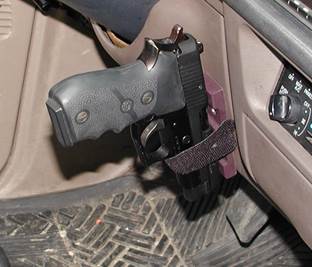
For example, there are shelves or mirrors that you simply mount to any wall and look and function just like regular furniture. However, they contain locking mechanisms and mounting options within them to hold things like firearms, flashlights or just about anything your heart desires for additional safety and precautions. There are also holster systems that have a single holster which the firearm secures into, but the holsters themselves can then be inserted into straps or rigs that you can either wear on hand or attach to most anything you can think of. With these holster systems, you could do things like carry your holster inside an IWB holster as you walk around and then once in the car, simply remove the holster from your belt and insert it into a mount under the dashboard.
The only real downside to these style of holsters is that they very seldom are as proficient as holsters designed specifically for a single location. This does not mean they aren't viable options, just know that you may have to pay a little more care to how you wear these holsters throughout the day to ensure you don't print the firearm against over garments or move in positions that the holster's retention might not be able to prevent the firearm from falling free of the holster.
CANT OR TILT
The cant or tilt of a holster simply refers to the angle at which the firearm sits in the holster as carried. Many holsters that are designed for more concealability will have a forward style cant (meaning the grip angle as you would grab it in the holster is twisted forward so the muzzle points towards the rear and the handle is twisted higher in relation to how the firearm sits in the holster). This is to help move the base of the grip higher as it is worn and makes it less likely that clothing will print against the firearm. While this helps with concealability, it can actually increase the time needed to draw the firearm and put the muzzle on target as you now have to rock the firearm forward even more than normal before the barrel is lined up correctly.
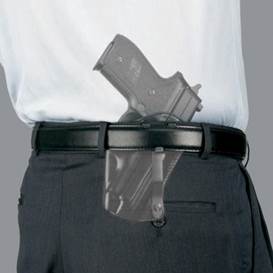
On the other hand, if you "cant" the holster rearward (meaning the muzzle is now twisted forward and the grip gets pushed further to the rear) it can decrease your draw time as the barrel is already partially pointed in the forward direction. Unfortunately, this does make it a little harder to conceal.
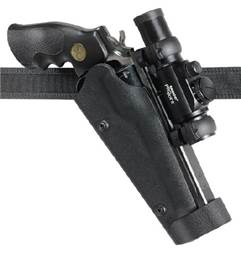
Holsters carried in various locations will require certain cants in order to best accommodate for either concealability or an easy draw motion. The real element to consider with a cant or tilt angle is what you're specifically attempting to accomplish - increased draw speed or concealability? The vast majority of holsters built for general purpose have a zero degree cant (meaning they aren't twisted and just sit vertically in the holster), while holsters built for more concealability tend to have a more forward cant (again, helping prevent clothing from printing against the grip) and holsters designed for competition tend to be canted to the rear (allowing for the fastest draw possible to help increase performance when under the clock).
ATTACHEMENT METHODS
Because of how vast and diverse holsters can be in attaching to our bodies or objects is really only limited to actual perception, understanding and simply ones imagination. However, there are a few methods that have become much more common throughout the industry and we will address the more common factors here.
BELT - Belt holsters simply have a couple of slots built into the back side of them where a belt slides through and then retains the holster to your hip. Depending on your pants and carry location, a little trick you can use to help with ensuring the holster is attached firmly is to use a belt loop from your pants in addition to the slits on the holster to help hold the holster in place. For example, run the belt through a pant belt loop, then a holster slit, then another belt loop, then the other holster slit and finally another belt loop that will secure the buckle. This is obviously not a requirement but can aid in many cases. You also need to ensure you have a proper belt and we'll discuss that in a further section.
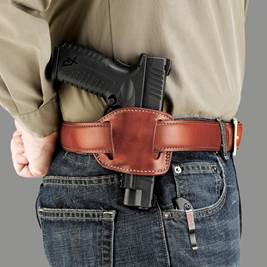
PADDLE - Holsters that have a "paddle" attachment are designed to be looped over the waistband. The paddle then sets against your side and the holster hangs over the outside of the pants. To maximize the performance, you should still wear a belt with these holsters but a definite bonus is they can be taken on and off relatively quickly without needing to unhinge your belt. They often come with "teeth" that will hook under the belt while worn to help ensure the holster can't simply pop-out of your pants, but important note that just prying the paddle back a little will let the belt slip free of these "teeth" and again make the holster easy to take on-or-off.
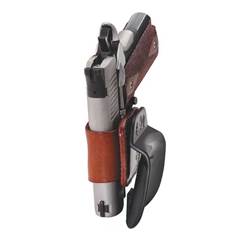
Another bonus to a paddle is it provides a broad base that fits up against your body and can help to prevent any twist that might occur during a draw motion, making them very reliable for a smooth draw. The downside is they do tend to push the firearm a little further from the body and this can cause some of them to be harder to conceal.
CLIPS & LOOPS - Holsters with clip attachments or loops that fasten usually wrap over something and secure the holster in place, like your waistband. The vast majority of IWB holsters will use clips or loops to secure to your side. Some are designed to allow you to even tuck your shirt in around the firearm and holster, but always behind the clip. This then lets you have a tucked in shirt while you are wearing your holster.
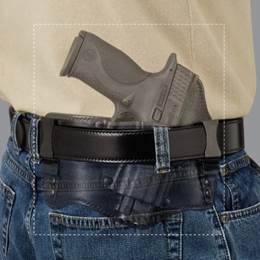
There are many different types of clips and many manufacturers even make different types for the same style holster. Some clips are designed more for durability, some more for concealability trying to show as little of the clip as possible to an observer. Ultimately, you should again be considering what wardrobe you intend to wear with the holster on a daily basis, like if your daily routine may require a stronger attachment or one that's simply more discreet.
HARNESSES - Holsters that use a harness can be very comfortable since they help to redistribute the added weight of a firearm across a wider surface and most often over your shoulders, which are better suited for carrying additional weight other than a waist. Many harnesses also come with attachments and additional securing points that allow the user to customize their rig and incorporate other tools like, flashlights, pepper spray, handcuffs, knives, multi-tools or just about anything preferred. Additionally, since all of these tools, pouches and holsters are all setup on a harness, it makes it incredibly easy to take the entire rig on-or-off.
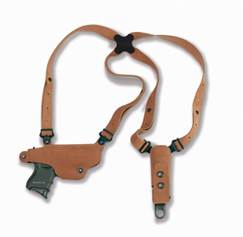
MODULAR - Modularity has become a huge element within the firearms community over the past decade. There are now a great many systems available that can allow you to quickly customize your entire kit, including where you put your holster.
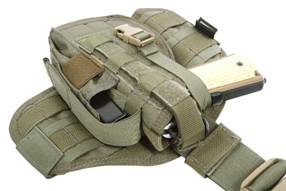
In the civilian or plain clothed law enforcement sense, some of these systems allow you to keep the same holster for your firearm but have multiple mounting points located throughout your daily environment so that you don't always have to keep the firearm on hand. An example of these style of systems in this capacity was explained in the "Universal" Mount section above.
With a more tactical approach for military or law enforcement roles, modular systems are incredibly common, for example when something is MOLLE compliant. Many tactical style gun holsters come with adaptive kits to help you latch the holster to a battle belt, tactical vest, or possibly a drop-leg rig.
Drop-Leg Holsters are designed to fit below the body armor usually worn in these capacities and make the firearm much easier to access. Usually attached by a strap at the top to the belt and then secured by straps around the thigh, there are a wide range of holsters designed for this purpose and some of them have just an attachment plate that secures to the leg. This plate can then accommodate for a holster, magazine pouches or any number of other possibilities.
PROPER BELTS
Often times overlooked and not considered, if you don't have a proper belt to accommodate for a holster, you are setting yourself up for hardships and additional challenges. The kind of belts needed to be worn in conjunction with a firearm are much thicker and sturdier than traditional belts. One of the most common problems to occur with belts not made for carrying a firearm is for a twisting motion to occur during a draw stroke. When you attempt to draw your firearm from the holster, a standard belt doesn't have the rigidity needed to prevent the upward pull on the firearm from twisting the belt and creates a pinching motion between the holster and your side making it difficult to cleanly free the firearm from the holster. Belts designed for use with holsters are very difficult to twist and allow for a much easier and smooth draw. The two most common are Leather and Nylon Belts and should always be considered in conjunction with a holster.
Leather belts are very comfortable, but most important of all, they don't look at all uncommon to regular style leather belts that are far less durable. As with leather holsters, leather belt will actually begin to form to you the longer you wear it and will adjust to become more comfortable over time. Since a great many of these leather belts are rather fashionable as well, it actually helps to conceal the fact you are wearing a firearm as the belt seems ordinary. The only real downside to these belts is that their buckles are normally preset sizes and the belt can't fit as perfectly to your hips as belts with a more slide style buckle. Available in many traditional colors, leather belts are perfect choices for every day concealed carry or for professionals that carry firearms routinely in non-uniform attire.
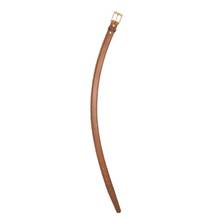
Nylon belts that are designed for holsters have become the industry standard for more tactical style uses. Usually fastened by a slide buckle, they will fit you perfect every time you put them on. Many of them even have additional hooks or anchors sewn into their structure and are often referred to as "Rigger's Belts". These belts are very durable and sometimes even come with additional Velcro™ patches that will allow some types of gear and holsters to lock into a specific location on the belt. The only real down side is they have a very distinctive look to them and are easily recognizable, even to people not entirely familiar with firearms, identifying the type of belt worn by people who perform tactical style functions. Not to say that only tactical individuals wear these belts, simply that they have become recognizable as a favored among that demographic. So while a very good choice from a functional standpoint, they aren't very discreet.
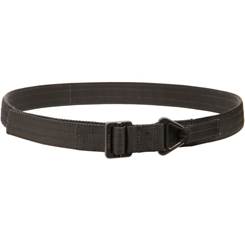
SELECTING THE CORRECT HOLSTER
Your choice in holster revolves around what firearm you're carrying, where you're carrying it (i.e. on your hip, around your ankle, etc.) and how you're carrying it (concealed, open carry, duty, tactical, etc). Here are some important factors to consider and remember when searching for the right holster to serve specifics needs and functionality.
STEP 1
FIREARMS MAKE & MODEL - Is the holster going to properly fit your firearm? Sad to say that a great many firearms are not even addressed by most of the general style holsters designed by lead manufacturers. Most of the time, standard and basic holsters are usually made for commonly purchased or used firearms and more often than not, catered to right handed users as there are statistically less left handed individuals in the world.
While this means that the vast majority of common firearms are addressed, especially for right handed shooters, it can certainly lead to some frustration if your firearm has some kind of modification, additional accessory or work and more consistently if you're not using the same firearms generally considered to be popular models. Many times, someone will find the holster they really desire only to find out that it is not compatible with their carry firearm of choice or that it's only available in right handed when they're a left handed shooter. A good place to begin with is your specific firearm and then work from there. In addition, one may want to consider shopping holsters in advance before purchasing or committing to a specific make or model to ensure availability and more importantly, ability for everyday carry.
STEP 2
ACCESSABILITY - Does the holster allow you easy access to the firearm and prevent access to someone else potentially drawing your firearm? This leads directly into what is commonly referred to as the "level" of holster (for more info, please refer to the "Level" portion of "Understand Holsters"). However, this is not the only consideration to take into account!
We now need to consider the elements of concealability, durability and which works best for your intended use. If you wish to carry concealed, then typically you want the holster to be a sleek form fitting design that hugs to the body in the location where it will be worn for it to be easier to conceal under clothing. You might consider something with a bit of a forward cant (see the "Cant & Tilt" portion of "Understanding Holsters"). Typically holsters that are "Level 1" are better suited for a concealed carry vs. most "Paddle" holsters that don't always make for an easy conceal (see "Paddle" under the "Attachment Methods" of "Understanding Holsters").
If you intend to wear it openly instead, then it might prove more beneficial to consider the more bulky and higher level holsters as they are designed for an easy draw for the individual wearing it as well as far more difficult for someone else to draw the firearm.
If you're searching for a competition style holster then you may want one that pushes away from the body a little, with a backward cant (see the "Cant & Tilt" section of "Understanding Holsters") and as minimal retention as possible to maximize your draw time.
STEP 3
DAILY ROUTINE - Is the holster secure enough to retain the firearm during the activities you'll be performing while wearing it? While this may be similar to the second consideration listed above, it is another important element that should be thought of entirely separately. To give an example, if you continually get in-and-out of vehicles, always consider if there is potential for the firearm to literally fall free from the holster or will the entire holster simply fall off as one goes through different positions. If someone were to surprise you, can they dislodge your firearm or worse, gain access to it if you're not prepared?
Back-track to step 2 for a second where we're thinking about the holster and firearm as worn while we are stationary and then think about outside elements that might affect every-day carry, but now think about all the different ways we would move around and interact within our daily environment always taking into account outside elements as well.
STEP 4
LOCATION - Where does it make the most sense to have the holster located while worn? It's time to really put on your "what-if" cap and begin going through your regular day-to-day routine. As you go through each stage of your day, you should game plan a few potential scenarios that are reasonable where you might need to draw your firearm. As you go through this planning stage, you can begin to identify where on your body having a holster will prove to be the best possible use in the majority of likely scenarios. For more on some of the various carry locations available please view our "Carry Locations" section in "Understanding Holsters".
STEP 5
CONCEALMENT - If you're looking to conceal your firearm, will the holster be effectively concealed in the intended location with the clothing you wear on a daily basis?
A simple way to check ahead of time is to put on the wardrobe in question, step in front of a mirror, and then go through various motions like twisting, stretching your arms or legs in various directions, sit, stand and all the while look where you're intended carry location is in the mirror. It might prove beneficial to enlist the help of a friend or family member for a second set of eyes and a very viable second opinion.
You want to ensure you have a good 3" to 4" of overlap from where the bottom of the visible holster would be. This means if you're going to carry IWB (see "Hip Carry" portion of "Carry Location" section in "Understanding Holsters") then you need a few inches of clothing below the top of your pant waistband, and if you're carrying outside the waistband then you need an additional few inches, based primarily on the barrel length of your intended firearm plus approximately 2" for the holster. Remember though that holsters that sit outside the waistband for concealment tend to push the firearm higher up on the hip. A general guideline is the trigger guard of the firearm which should always be just below the waistband of the pants.
While 3" to 4" of additional clothing can help, you also need to ensure that your clothing falls loosely over the intended area. If it is too tight then realistically it will "print" the outline of the firearm through the garment. In some states printing can still be considered brandishing a firearm and is illegal. There is no perfect answer, but the best thing to do is to find out the local laws about concealing your firearm, test out your wardrobe and just be confident before you begin selecting the potential holsters you may choose to carry. Always double-check again once you get your holster.
STEP 6
PROFICIENCY - Once you get your holster it is vitally important that you practice with it so you become as familiar as possible with it ensuring safety and proficiency. A good idea for people who are carrying a new holster for the first time is to simply put it on and wear it around the house for a while with an unloaded firearm until you're completely comfortable with it. Once it isn't so new or awkward, then start using a loaded firearm and eventually working it to being fully comfortable and confident with it.
If you do routinely wear a holster you should find a range that will let you safely practice using it with live ammunition. As always, we highly recommend you routinely attend training from reputable professionals in order to ensure you're always comfortable and confident in your ability to utilize your firearm safely and effectively.
Add New
Comments
no comments found